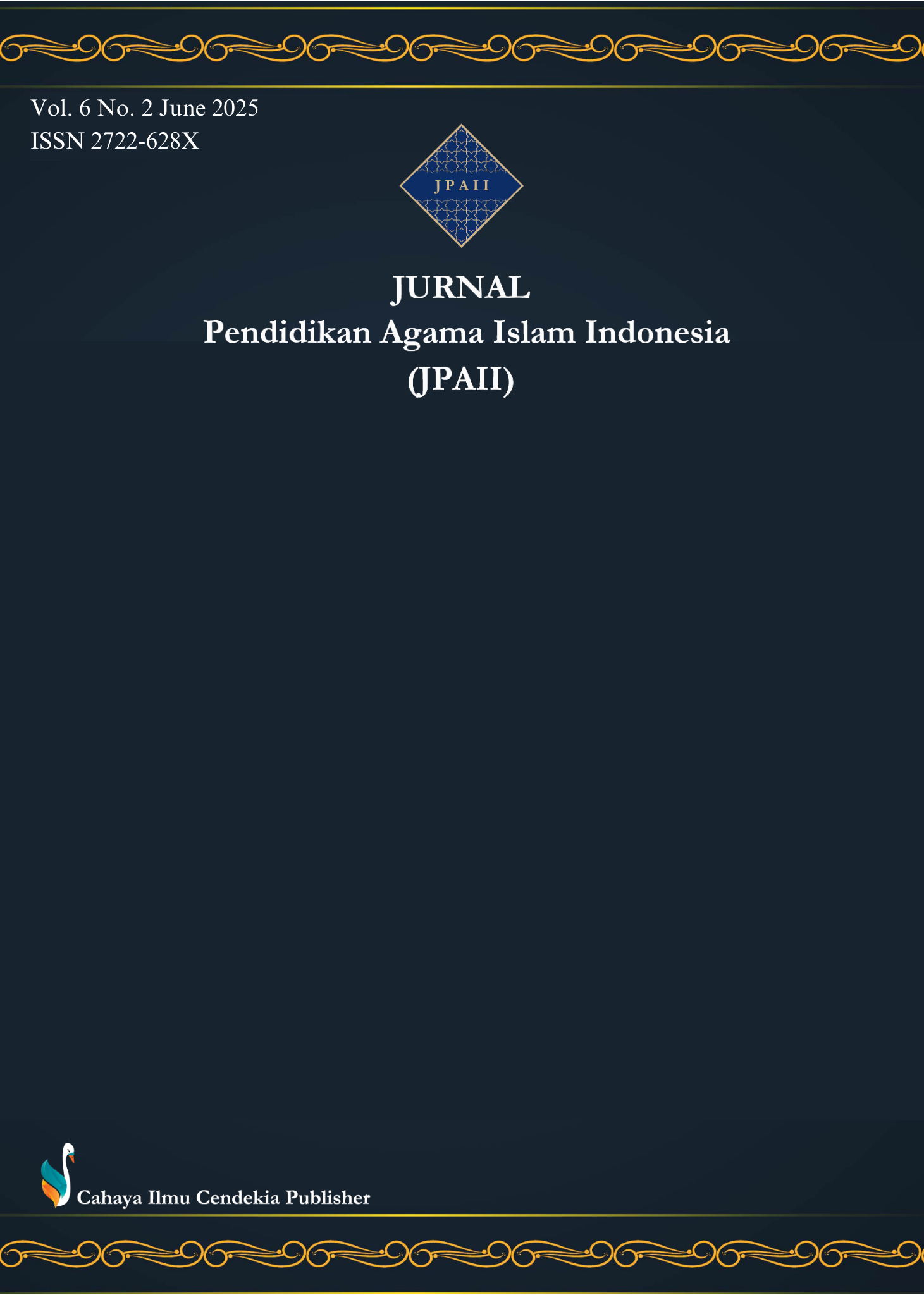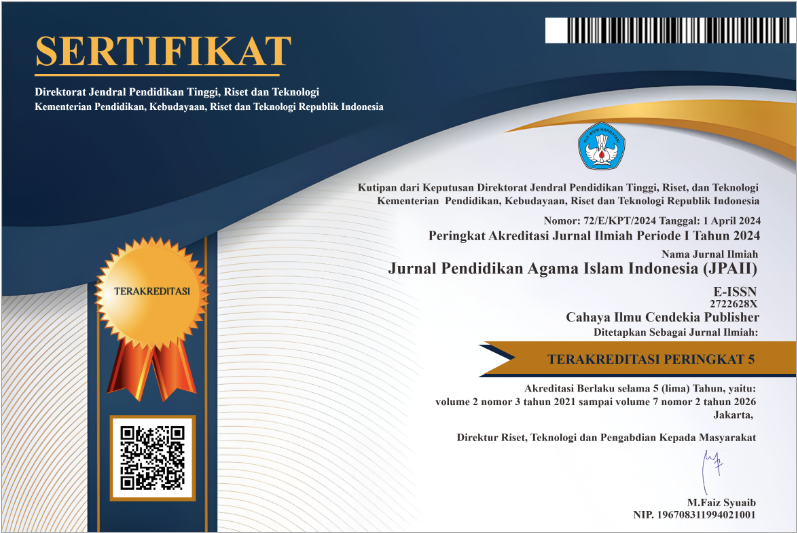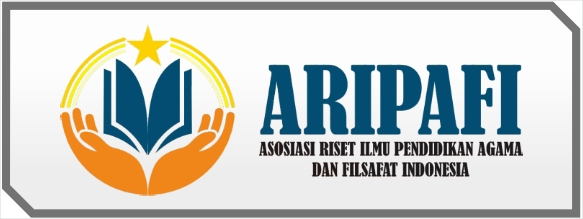Feminism Among Muslimah Students: A Gender Perspective Study Through Islamic Values
Abstract
Purpose of the study: This research aims to understand how Muslimah students at the Faculty of Art and Design Education UPI interpret feminism in three main dimensions: humanization in peer relations, liberation: impact on the self, and transcendence: influence on religious understanding.
Methodology: A qualitative phenomenological technique was used in this investigation. In-depth interviews with Muslimah students at FPSD UPI were used to gather data, which were bolstered by document analysis and observation. The data was interpreted using thematic analysis, which concentrated on the aspects of transcendence, liberation, and humanisation within the context of Islamic principles.
Main Findings: The study reveals that Muslimah students at FPSD UPI interpret feminism in diverse ways across three dimensions: humanization, liberation, and transcendence. Feminism encourages more inclusive social interactions, inspires artistic expression on gender themes, and prompts reflective engagement with religious teachings. While some view feminism as compatible with Islamic values, others experience tension, showing varied levels of internalization shaped by personal, cultural, and spiritual contexts.
Novelty/Originality of this study: This study provides a fresh perspective by examining how Muslimah students in a department of art and design see feminism from an Islamic perspective. By presenting feminism in three interconnected dimensions: humanization, freedom, and transcendence, it contributes to the current conversation by emphasising the contextual interaction between gender consciousness, artistic expression, and religious knowledge in an academic context with cultural roots.
References
M. Moqadam, “Fractal scaling of feminist politics and the emergence of woman life freedom movement in Iran,” Soc. Forces, vol. 1, no. 1, p. soaf050, 2025, doi: 10.1093/sf/soaf050.
N. Ourahmoune and H. El Jurdi, “The march for gender equality of Algerian women: The struggle for spatial and historical recognition,” Gender, Work Organ., vol. 31, no. 3, pp. 1012–1030, 2024, doi: 10.1111/gwao.13082.
B. Russell, D. Oswald, and M. K. Cotter, “What makes a liberal feminist? Identifying predictors of heterosexual women and men’s liberal feminist ideology,” Anal. Soc. Issues Public Policy, vol. 24, no. 1, pp. 241–260, 2024, doi: 10.1111/asap.12383.
F. Höglund and M. Flinkfeldt, “The practical realization of the feminist welfare state: Equal sharing and gender equality in institutional interaction about parental leave in Sweden,” Fem. Psychol., vol. 34, no. 2, pp. 309–327, 2024, doi: 10.1177/09593535231217135.
R. A. Ojwala, S. Buckingham, F. Neat, and M. Kitada, “Understanding women’s roles, experiences and barriers to participation in ocean science education in Kenya: recommendations for better gender equality policy,” Mar. Policy, vol. 161, no. December 2023, p. 106000, 2024, doi: 10.1016/j.marpol.2023.106000.
S. Gannon, “Refractory accounts of feminist educational policy work: the case of Gender Equity: A Framework For Australian Schools,” Curric. Perspect., pp. 9–22, 2024, doi: 10.1007/s41297-024-00251-0.
B. E. L. Kaunda and N. C. Shereni, “Gender equality and sustainability in the tourism industry: feminist perspectives,” J. Hum. Resour. Hosp. Tour., vol. 1, no. 1, pp. 149–169, 2023, doi: 10.1080/15332845.2023.2253685.
M. Karambiri, A. H. G. Ville, G. Y. Wong, A. Jimenez-Aceituno, A. Downing, and M. Brockhaus, “What is the Problem of Gender Inequality Represented to be in Inter-National Development Policy in Burkina Faso?,” Forum Dev. Stud., vol. 51, no. 1, pp. 71–100, 2024, doi: 10.1080/08039410.2024.2303004.
N. Rofiq, “Gender, Faith, and Reform: A Narrative Review of Islamic Feminism and Public Policy,” Sinergi Int. J. Islam. Stud., vol. 2, no. 2, pp. 66–81, 2024, doi: 10.61194/ijis.v2i2.600.
M. Daneshpour and S. H. Firooz, “Women, Life, Freedom: The New Unveiling of Feminism,” J. Fem. Fam. Ther., vol. 34, no. 3, pp. 390–394, 2022, doi: 10.1080/08952833.2022.2142450.
P. A. Lestari, “Reclaiming Faith and Justice: A Narrative Review of Islamic Feminism,” Sinergi Int. J. Islam. Stud., vol. 2, no. 3, pp. 176–189, 2024, doi: 10.61194/ijis.v2i3.608.
I. Kitta and M. C. Cardona-Moltó, “Students’ perceptions of gender mainstreaming implementation in university teaching in Greece,” J. Gend. Stud., vol. 31, no. 4, pp. 457–477, 2022, doi: 10.1080/09589236.2021.2023006.
S. Nojan, “Racial-Religious Decoupling in the University: Investigating Religious Students’ Perceptions of Institutional Commitment to Diversity,” AERA Open, vol. 9, no. 1, pp. 1–22, 2023, doi: 10.1177/23328584221121339.
T. Thoriquttyas, A. M. Nasih, and A. Sultoni, “Women Right and Gender Equality in Islam: A Survey of Students Perception on Feministic Discourse,” Proc. Int. Semin. Lang. Educ. Cult. (ISoLEC 2021), vol. 612, no. ISoLEC, pp. 307–311, 2022, doi: 10.2991/assehr.k.211212.058.
Mustofa, D. F. Karya, and A. Halim, “Indonesian Students’ Perception of Gender Equity in Education,” Pegem Egit. ve Ogr. Derg., vol. 11, no. 4, pp. 185–196, 2021, doi: 10.47750/pegegog.11.04.18.
D. Fidhayanti et al., “Rethinking Islamic Feminist Thought on Reinterpreting the Qur’an: An Analysis of the Thoughts of Aminah Wadud, Fatima Mernissi, Asma Barlas, and Riffat Hassan,” Tribakti J. Pemikir. Keislam., vol. 35, no. 1, pp. 1–22, 2024, doi: 10.33367/tribakti.v35i1.4564.
M. T. Khalil and Y. M. Saputro, “Balancing Freedom of Expression and Authority in Democratic Islamic Education,” Multicult. Islam. Educ. Rev., vol. 3, no. 1, pp. 75–86, 2025, doi: 10.23917/mier.v3i1.9914.
D. Tuki, “Examining the effect of gender, education and religion on attitudes toward gender equality in Nigeria,” Polit. Groups, Identities, vol. 13, no. 1, pp. 1–27, 2024, doi: 10.1080/21565503.2024.2304311.
A. Şenel and S. Demmrich, “Prospective Islamic Theologians and Islamic religious teachers in Germany: between fundamentalism and reform orientation,” Br. J. Relig. Educ., vol. 46, no. 4, pp. 389–407, 2024, doi: 10.1080/01416200.2024.2330908.
W. J. Creswell and J. D. Creswell, Research Design: Qualitative, Quantitative and Mixed Methods Approaches (5th ed). Thousand Oaks, CA: Sage Publication., 2018.
M. B. Miles, A. M. Huberman, and J. Saldana, Qualitative Data Analysis A Methods Sourcebook. SAGE Publications, 2018.
N. Carter, D. Bryant-Lukosius, A. Dicenso, J. Blythe, and A. J. Neville, “The use of triangulation in qualitative research,” Oncol. Nurs. Forum, vol. 41, no. 5, pp. 545–547, 2014, doi: 10.1188/14.ONF.545-547.
M. Naeem, W. Ozuem, K. Howell, and S. Ranfagni, “A Step-by-Step Process of Thematic Analysis to Develop a Conceptual Model in Qualitative Research,” Int. J. Qual. Methods, vol. 22, no. October, pp. 1–18, 2023, doi: 10.1177/16094069231205789.
S. Farida, “Analysis Hilmi Ali Yafie’s Opinion on Gender Equality in Islamic Education and Its Relevance to Madurese Society,” SYAIKHUNA J. Pendidik. dan Pranata Islam STAI Syichona Moh. Cholil Bangkalan, vol. 14, no. 2, pp. 158–176, 2024, doi: 10.62730/syaikhuna.v15i2.7484.
L. S. Son Hing, N. Sakr, J. B. Sorenson, C. S. Stamarski, K. Caniera, and C. Colaco, “Gender inequities in the workplace: A holistic review of organizational processes and practices,” Hum. Resour. Manag. Rev., vol. 33, no. 3, p. 100968, 2023, doi: 10.1016/j.hrmr.2023.100968.
T. Saguy, M. Reifen-Tagar, and D. Joel, “The gender-binary cycle: The perpetual relations between a biological-essentialist view of gender, gender ideology, and gender-labelling and sorting,” Philos. Trans. R. Soc. B Biol. Sci., vol. 376, no. 1822, 2021, doi: 10.1098/rstb.2020.0141.
E. Franken, F. Sharafizad, and K. Brown, “Gender, vulnerabilities, and how the other becomes the otherer in academia,” Gender, Work Organ., vol. 31, no. 4, pp. 1342–1365, 2024, doi: 10.1111/gwao.13096.
R. Sabates-Wheeler and J. P. Barker, “The place of religious inequalities within international development and humanitarian response frameworks: Lessons from Iraq,” World Dev., vol. 173, no. October 2023, p. 106417, 2024, doi: 10.1016/j.worlddev.2023.106417.
B.-L. Henze, S. Buhl, E. Kolbe, and F. Asbrock, “Should we all be feminists? Development of the Liberal Feminist Attitudes Scale,” Front. Soc. Psychol., vol. 2, no. 1, pp. 1–22, 2024, doi: 10.3389/frsps.2024.1329067.
H. Eisenstein, “The Gender of Bureaucracy: Reflections on Feminism and the State,” in Women, Social Science and Public Policy, Routledge, 2024.
D. G. Calabrò and S. Palmieri, “Teaching and learning feminisms with pacific islanders: an emotional journey,” Dev. Pract., vol. 34, no. 7, pp. 834–846, 2024, doi: 10.1080/09614524.2024.2332263.
S. E. Nicholson and P. A. Pasque, “An Introduction to Feminism and Feminist Perspectives in Higher Education and Student Affairs,” in Empowering Women in Higher Education and Student Affairs, Routledge, 2011.
S. Marine, Reflections from “Professional Feminists” in Higher Education Women’s and Gender Centers at the Start of the Twenty-First Century. Routledge, 2011.
M. F. Noor, “A Feminist Interpretation of Qur’Anic Texts By Amina Wadud and Zaitunah Subhan,” INTIHA Islam. Educ. J., vol. 1, no. 3, pp. 144–156, 2024, doi: 10.58988/intiha.v1i3.311.
N. M. Dewi, N. J. Abdulhassan, and H. A. Quddoos, “The Influence of Islamic Religious Education Learning in Forming Students’ Character and Noble Morals,” J. Pendidik. Agama Islam Indones., vol. 6, no. 1, pp. 18–25, 2025, doi: 10.37251/jpaii.v6i1.1554.
C. Morris, T. Hinton-Smith, R. Marvell, and K. Brayson, “Gender back on the agenda in higher education: perspectives of academic staff in a contemporary UK case study,” J. Gend. Stud., vol. 31, no. 1, pp. 101–113, 2022, doi: 10.1080/09589236.2021.1952064.
D. Bergoffen, “On Becoming Human and Being Humane: Human Rights, Women’s Rights, Species Rights,” Religions, vol. 15, no. 7, pp. 1–22, 2024, doi: 10.3390/rel15070822.
M. Gilang Ardela Mubarok and E. Muslihah, “The Role of Islamic Religious Education Teachers in Forming Religious Attitudes and Religious Moderation,” Geneologi PAI, vol. 9, no. 01, pp. 115–130, 2022, doi: 10.37251/jpaii.v6i1.1566.
T. Verge, “Gender Equality Policy and Universities: Feminist Strategic Alliances to Re-gender the Curriculum,” J. Women, Polit. Policy, vol. 42, no. 3, pp. 191–206, 2021, doi: 10.1080/1554477X.2021.1904763.
S. Shaikh, “Friendships, Fidelities and Sufi Imaginaries: Theorizing Islamic Feminism,” Religions, vol. 14, no. 9, pp. 1–22, 2023, doi: 10.3390/rel14091082.
H. Winkel, “Islamic Feminism. Thinking Gender Justice as a Religious Knowledge Practice,” in Exploring Islam beyond Orientalism and Occidentalism, Springer VS, Wiesbaden, 2021. doi: 10.1007/978-3-658-33239-6_8.
Dr. Rukhsana Shaheen Waraich, D. M. Fayaz, and G. G. Khan, “Women Empowerment through Quran: An Alternative Narrative to the Western Liberal Feminism,” Al-Qamar, vol. 4, no. 4, pp. 23–44, 2021.
I. Ismail, “The Development of Islamic Feminism in Malaysia,” Int. J. Islam. Thought, vol. 23, no. 1, pp. 39–49, 2023, doi: 10.24035/IJIT.23.2023.254.
M. F. Husaeni, A. Kosasih, and U. Supriadi, “Challenging gender mainstreaming through the narrative of Islamic youth organization: A case study on Persis in Indonesia,” Asian J. Women’s Stud., vol. 29, no. 1, pp. 1–22, 2023, doi: 10.1080/12259276.2023.2186631.
D. Kloos and N. Ismah, “Siting Islamic feminism: The Indonesian Congress of Women Islamic Scholars and the challenge of challenging patriarchal authority,” Hist. Anthropol. Chur., vol. 34, no. 5, pp. 818–843, 2023, doi: 10.1080/02757206.2023.2249495.
M. Pratt, A. M. Zvonkovic, and R. F. Oswald, “This unique and precious opportunity: A conversation among feminist administrators about reclaiming the transformative potential of post-pandemic higher education,” J. Fam. Theory Rev., vol. 17, no. 1, pp. 127–133, 2025, doi: 10.1111/jftr.12613.
A. Jedinger and P. Siegers, “Religion, spirituality, and susceptibility to conspiracy theories: Examining the role of analytic thinking and post-critical beliefs,” Polit. Relig., vol. 1, no. 1, pp. 389–409, 2024, doi: 10.1017/S1755048324000130.
T. Yuniartin, S. Subaidah, D. Feriana, M. Arman, and D. Saepuloh, “Evaluation of Islamic Education: Integrating Cognitive, Moral, and Spiritual Aspects Based on The Qur’ an and Hadith,” J. Pendidik. Agama Islam Indones., vol. 5, no. 5, pp. 161–169, 2024, doi: 10.37251/jpaii.v5i4.1267.
G. Jung and M. Moon, “‘Feminism is like a light to me’: The collective process of feminist awakening among young female college students in South Korea,” Asian J. Soc. Sci., vol. 53, no. 1, p. 100177, 2025, doi: 10.1016/j.ajss.2024.10.002.
J. Gunnarsson Payne and S. Tornhill, “The enemy’s enemy: feminism at the crossroads of neoliberal co-optation and anti-gender conservatism,” J. Polit. Ideol., vol. 28, no. 1, pp. 62–82, 2023, doi: 10.1080/13569317.2021.1921937.
S. S. Karimullah and S. R. Aliyah, “Feminist Criticism of Traditional Understanding of Women’s Roles in Islam,” An-Nisa J. Kaji. Peremp. dan Keislam., vol. 16, no. 2, pp. 195–214, 2023, doi: 10.35719/annisa.v16i2.177.
S. Pertek, K. Block, L. Goodson, P. Hassan, J. Hourani, and J. Phillimore, “Gender-based violence, religion and forced displacement: Protective and risk factors,” Front. Hum. Dyn., vol. 5, no. 1, pp. 1–15, 2023, doi: 10.3389/fhumd.2023.1058822.
Copyright (c) 2025 Firzana Farah Amira, Hilman Taufiq Abdillah

This work is licensed under a Creative Commons Attribution 4.0 International License.
Authors who publish with this journal agree to the following terms:
- Authors retain copyright and acknowledge that the Jurnal Pendidikan Agama Islam Indonesia (JPAII) is the first publisher licensed under a Creative Commons Attribution 4.0 International License.
- Authors are able to enter into separate, additional contractual arrangements for the non-exclusive distribution of the journal's published version of the work (e.g., post it to an institutional repository or publish it in a book), with an acknowledgment of its initial publication in this journal.
- Authors are permitted and encouraged to post their work online (e.g., in institutional repositories or on their website) prior to and during the submission process, as it can lead to productive exchanges and earlier and greater citation of published work.







.png)
.png)





















